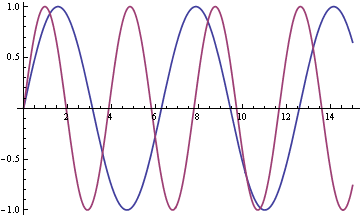Gil Kalai’s blog featured a guest post the other day about breastfeeding twins.
The post commented in passing that
φ, the golden ratio, is the number hardest to approximate by rationals.
What could this possibly have to do with breastfeeding? The post described a pair of twins with hunger cycles sin(t) and sin(φt), functions that hardly ever come close to synchronizing. The constant φ is difficult to approximate by rational numbers, in a sense that I describe below, and this explains why the two functions are so often out of sync.

In one sense, φ is very easy to approximate by rationals. The ratio of any two consecutive Fibonacci numbers is a rational approximation to φ, the approximation improving as you go further out the Fibonacci sequence. The same is true for any generalized Fibonacci sequence, though the approximation may not be very good until you go out a ways in the sequence, depending on your starting values. So φ is easy to approximate in the sense that it is convenient to think of approximations.
Now let’s look at the sense in which φ is hard to approximate. How accurately can you approximate an irrational number ξ by a rational number a/b? Obviously you can do a better and better job by picking larger and larger fractions. For example, you could always take the first n digits of the decimal expansion of ξ and use that to make a rational approximation with denominator 10n. But that might be very inefficient. How well can you approximate ξ relative to the size of the denominator? This question is answered in general by a theorem of Hurwitz.
Given any irrational number ξ, there exist infinitely many different rational numbers a/b such that
The decimal expansion idea mentioned above is wasteful because the error goes down in proportion to the denominator, while Hurwitz theorem says it’s possible for the error to go down in proportion to the square of the denominator.
Can we do any better than Hurwitz theorem? For example, is it possible to replace √5 with some larger constant? Not in general, and the golden ratio φ provides the counterexample to any would-be refinements of Hurwitz theorem. The constant φ is a worst case. That is the sense in which φ is the number hardest to approximate by rationals. If φ and some related numbers are excluded, then the constant √5 can be increased.
Going back to breastfeeding, suppose the twins had hunger cycles sin(t) and sin(ξt). If ξ is irrational, the two curves will never exactly have the same period. But if ξ were equal to a rational number a/b, then the two functions would have a common period of length bπ if a is even or of length 2bπ if a is odd. If ξ were (approximately) equal to a/b with b small, the feedings would often synchronize. Since φ requires large values of b to make a good rational approximation, ξ = φ is a worst case.
Related posts:

Interesting. I always think of phi as being the irrational number whose rational approximations are the most beautiful, since it is the value of the continued fraction, [1, 1, 1, 1, …]. I’ll have to work through the details of Hurwitz’s theorem.
Just love the combination of breastfeeding and maths!
I breastfed my boy-girl twins until they are 14 months old, always one right after the other, rational a/b :)
I have breastfed my twins since birth a year ago, and I am quite glad that I haven’t encountered this scenario frequently.
Sorry, I don’t understand where “bπ if a is even” comes from, should always be 2bπ IMO. E.g. sin(x) and sin(2/3*x) have common period of 6π. Looks like a mistake?
The mean absolute error that is helpful is the length of time is the sum of the mean time to feed one infant plus the time it takes for Mom to fall asleep.